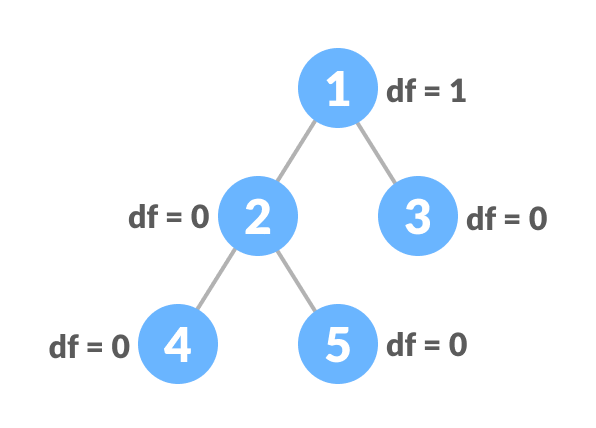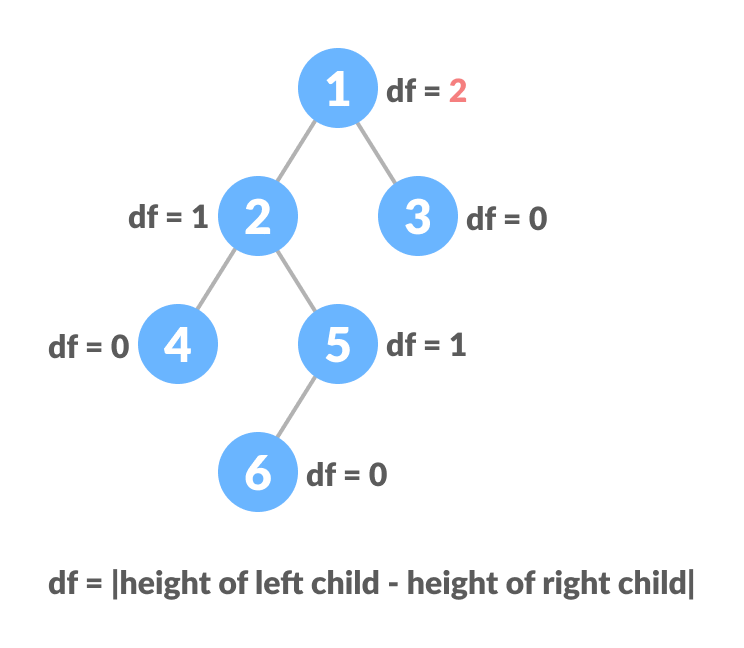How to Draw a Balanced Binary Tree
Balanced Binary Tree
In this tutorial, you will learn about a balanced binary tree and its different types. Also, you will find working examples of a balanced binary tree in C, C++, Java and Python.
A balanced binary tree, also referred to as a height-balanced binary tree, is defined as a binary tree in which the height of the left and right subtree of any node differ by not more than 1.
To learn more about the height of a tree/node, visit Tree Data Structure.Following are the conditions for a height-balanced binary tree:
- difference between the left and the right subtree for any node is not more than one
- the left subtree is balanced
- the right subtree is balanced


Python, Java and C/C++ Examples
The following code is for checking whether a tree is height-balanced.
# Checking if a binary tree is height balanced in Python class Node: def __init__(self, data): self.data = data self.left = self.right = None class Height: def __init__(self): self.height = 0 def isHeightBalanced(root, height): left_height = Height() right_height = Height() if root is None: return True l = isHeightBalanced(root.left, left_height) r = isHeightBalanced(root.right, right_height) height.height = max(left_height.height, right_height.height) + 1 if abs(left_height.height - right_height.height) <= 1: return l and r return False height = Height() root = Node(1) root.left = Node(2) root.right = Node(3) root.left.left = Node(4) root.left.right = Node(5) if isHeightBalanced(root, height): print('The tree is balanced') else: print('The tree is not balanced') // Checking if a binary tree is height balanced in Java // Node creation class Node { int data; Node left, right; Node(int d) { data = d; left = right = null; } } // Calculate height class Height { int height = 0; } class BinaryTree { Node root; // Check height balance boolean checkHeightBalance(Node root, Height height) { // Check for emptiness if (root == null) { height.height = 0; return true; } Height leftHeighteight = new Height(), rightHeighteight = new Height(); boolean l = checkHeightBalance(root.left, leftHeighteight); boolean r = checkHeightBalance(root.right, rightHeighteight); int leftHeight = leftHeighteight.height, rightHeight = rightHeighteight.height; height.height = (leftHeight > rightHeight ? leftHeight : rightHeight) + 1; if ((leftHeight - rightHeight >= 2) || (rightHeight - leftHeight >= 2)) return false; else return l && r; } public static void main(String args[]) { Height height = new Height(); BinaryTree tree = new BinaryTree(); tree.root = new Node(1); tree.root.left = new Node(2); tree.root.right = new Node(3); tree.root.left.left = new Node(4); tree.root.left.right = new Node(5); if (tree.checkHeightBalance(tree.root, height)) System.out.println("The tree is balanced"); else System.out.println("The tree is not balanced"); } } // Checking if a binary tree is height balanced in C #include <stdio.h> #include <stdlib.h> #define bool int // Node creation struct node { int item; struct node *left; struct node *right; }; // Create a new node struct node *newNode(int item) { struct node *node = (struct node *)malloc(sizeof(struct node)); node->item = item; node->left = NULL; node->right = NULL; return (node); } // Check for height balance bool checkHeightBalance(struct node *root, int *height) { // Check for emptiness int leftHeight = 0, rightHeight = 0; int l = 0, r = 0; if (root == NULL) { *height = 0; return 1; } l = checkHeightBalance(root->left, &leftHeight); r = checkHeightBalance(root->right, &rightHeight); *height = (leftHeight > rightHeight ? leftHeight : rightHeight) + 1; if ((leftHeight - rightHeight >= 2) || (rightHeight - leftHeight >= 2)) return 0; else return l && r; } int main() { int height = 0; struct node *root = newNode(1); root->left = newNode(2); root->right = newNode(3); root->left->left = newNode(4); root->left->right = newNode(5); if (checkHeightBalance(root, &height)) printf("The tree is balanced"); else printf("The tree is not balanced"); } // Checking if a binary tree is height balanced in C++ #include using namespace std; #define bool int class node { public: int item; node *left; node *right; }; // Create anew node node *newNode(int item) { node *Node = new node(); Node->item = item; Node->left = NULL; Node->right = NULL; return (Node); } // Check height balance bool checkHeightBalance(node *root, int *height) { // Check for emptiness int leftHeight = 0, rightHeight = 0; int l = 0, r = 0; if (root == NULL) { *height = 0; return 1; } l = checkHeightBalance(root->left, &leftHeight); r = checkHeightBalance(root->right, &rightHeight); *height = (leftHeight > rightHeight ? leftHeight : rightHeight) + 1; if (std::abs(leftHeight - rightHeight >= 2)) return 0; else return l && r; } int main() { int height = 0; node *root = newNode(1); root->left = newNode(2); root->right = newNode(3); root->left->left = newNode(4); root->left->right = newNode(5); if (checkHeightBalance(root, &height)) cout << "The tree is balanced"; else cout << "The tree is not balanced"; } Balanced Binary Tree Applications
- AVL tree
- Balanced Binary Search Tree
Source: https://www.programiz.com/dsa/balanced-binary-tree
0 Response to "How to Draw a Balanced Binary Tree"
Postar um comentário